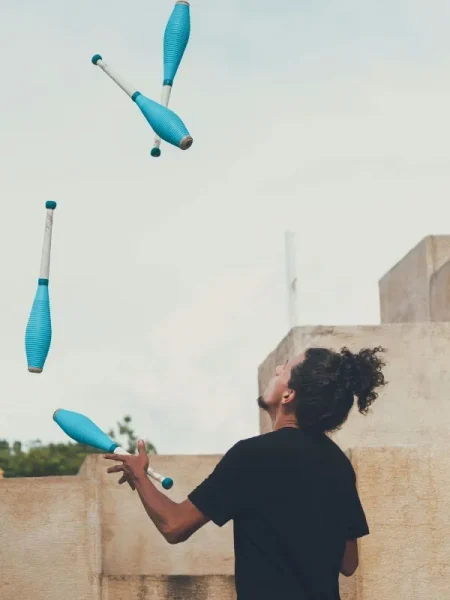Juggling Clubs 101
Learn what juggling clubs are, why switch to clubs, where to practice, how to juggle 3 clubs, harder tricks, good juggling club brands and more
What Is a Juggling Club, Exactly?
Okay, let’s clear something up: juggling clubs aren’t bowling pins. They look a bit like them, but they’re lighter, balanced differently and built to spin – not smash your foot.
A standard juggling club has:
– A handle (thin, usually taped for grip)
– A body (the fat, rounded part)
– Two ends: the knob (bottom of the handle) and the cap (top of the body)
They’re designed to rotate once per throw. Not twirl wildly. Not float up stiff. One smooth, clean spin – that’s the magic formula.
Popular brands? Henry’s, Play Juggling and Renegade all make solid beginner-friendly clubs. Something like the Henry’s Albatros or Play PX3 is forgiving, durable and feels good in your hand.
Why Switch to Clubs at All?
So, you’ve mastered juggling balls – or maybe you’ve just gotten curious after seeing someone fling a set of bowling-pin-looking things with a weird sense of grace. Juggling clubs can look intense, even intimidating. And yeah, they are a bit trickier than balls. But not by as much as you might think.
Here’s the truth: if you can juggle three balls, you’re halfway there. Clubs just add a new layer – the spin. Once your brain and hands get that rhythm down, everything else builds from it.
But why switch to juggling clubs?
Juggling clubs has a kind of drama to it. They move differently. They make a gentle “whoosh” as they rotate through the air. They demand attention – even if you’re not trying to perform.
But more than that:
– Clubs improve your spatial awareness like crazy.
– They force you to slow down and focus.
– They’re the gateway to passing, which is the most fun you can have with another juggler (seriously – it’s like a dance with objects).
And if you ever want to get into juggling torches, knives or clubs-on-fire (not recommended for beginners, but still tempting), then club juggling is the foundation.
Where to Practice Without Breaking Things
Let’s be careful here. Clubs aren’t soft like beanbags. They bounce, ricochet and sometimes fly off with the grace of a helicopter blade.
So, if you’re indoors:
– Choose a high-ceiling room
– Clear away anything breakable (plants, lamps, feelings)
– Lay down a carpet or yoga mat to soften the landing
Outdoors? Great idea. Flat grass is ideal. Avoid concrete at first – it’s rough on your clubs and your ego.
Pro tip: when you’re first starting, practice over your bed or couch. Not to be lazy – but to make your drops safer and your learning curve less brutal.
Start Small: One Club, No Pressure
Before you try to juggle three, get to know one club.
Here’s what to do:
– Hold it by the handle, near the knob.
– Toss it underhand to your other hand – just high enough to clear your head.
– The club should spin once in the air, tip over tail and land handle-first in your opposite hand.
That’s it. One throw, one catch.
It’s not about speed – it’s about clean rotation. If it spins too fast, your throw is too wristy. If it flails or flops? You’re probably letting your elbow do the work.
Try to toss ten clean spins in a row – same height, same rotation, same catch point. You’re building muscle memory and visual timing.



Add a Second Club: The “Flinch Zone”
Here’s where it gets interesting.
Hold one club in each hand. Toss the first one (just like before), and when it peaks, toss the second one. Catch, catch.
Easy in theory. Messy in real life.
You might flinch. That’s normal. Clubs are bigger and when they spin at your face, your instincts get loud. But trust the pattern. The throws don’t cross paths. There’s space. You’ll get used to it.
Keep practicing the two-club exchange until it’s smooth. This teaches your hands to take turns and your brain to chill during spin-time.
The Classic: Three-Club Cascade
Now we’re talking.
This is the holy grail of club juggling: the three-club cascade.
Start with two clubs in your dominant hand and one in the other. Sound familiar? It’s the same setup as with balls. But now the throws are slower, higher and spinny.
Here’s the rhythm:
– Toss club #1 from your dominant hand.
– When it peaks, toss club #2 from your non-dominant hand.
– When that peaks, toss club #3 from your dominant hand again.
– Catch. Repeat. Or don’t – it’ll all fall eventually. That’s fine.
Expect chaos at first. That’s not failure – that’s learning in disguise.
The cascade will probably feel wobbly and uneven for a while. Focus on these three things:
– Spin control: Every club should rotate once before it lands.
– Height: Keep tosses consistent – roughly head-to-chin level.
– Spacing: Don’t throw straight up – aim slightly across your body to form a clean X pattern.
What to Do When Everything Goes Wrong (And It Will)
Let’s normalize the mess.
Clubs will hit each other. You’ll toss one too far left. You’ll lose one behind your back. And sometimes, all three will end up on the floor before you even blink.
Here’s how to troubleshoot:
– Too much spin? You’re flicking your wrist too hard – keep the motion more from your arm.
– Dropping early? You’re rushing – wait for the peak before tossing.
– Moving forward? Try juggling in front of a couch or wall to train yourself to stay centered.
Every drop teaches something. Learn to love them – they’re how you get better.
Quick Tips from Jugglers Who’ve Been There
These might sound obvious – but they’re hard-won truths from anyone who’s learned clubs the hard way:
– Use your eyes, not your head – Don’t track the clubs by turning your whole face. Keep your head still; let your eyes follow the motion.
– Don’t chase bad throws – Let them fall. Reset. Chasing leads to chaos.
– Breathe – No seriously. It’s weird how many people hold their breath while juggling. Breathing smooths your rhythm.
– Record yourself – What feels chaotic might actually look fine. Or vice versa.
Once You’ve Got It—What’s Next?
When you can cascade three clubs for more than 10 throws consistently, congrats. You’ve officially arrived.
Now comes the fun part:
– Double spins – Same throw, but two rotations. Flashy and slow.
– Under the leg – Classic party trick move. Surprisingly doable.
– Club flourishes – Twirls, flips, hand rolls…all about style.
– Passing – Two people, six clubs. The holy grail of fun.
And of course, you can start playing with colors, LED clubs, even fire clubs (once you really know what you’re doing and have a fire blanket nearby).
The Brain Bonus
Weird side effect of learning clubs? Your brain levels up in sneaky ways.
– Better reaction time
– Faster pattern recognition
– Increased patience (no joke)
– A subtle confidence boost that leaks into other parts of your life
It becomes a practice. Like yoga or chess. Something you return to – not because you have to, but because it just feels good to keep the rhythm going.
A Few Tools and Brands to Check Out
If you’re shopping around, here are some solid club recommendations:
– Henry’s Albatros Training Clubs – Balanced, durable, a favorite among learners.
– Play PX3 Sirius – Soft knobs, solid feel, great for long sessions.
– Juggle Dream Trainer Clubs – Affordable and surprisingly good.
You’ll also want a decent juggling bag (they’re oddly shaped), and maybe some grip tape for sweaty summer sessions.
Final Throw
Look – juggling clubs isn’t easy. But it’s not mystical, either. It’s just a new rhythm. A new feel. A new way of tuning into your body and breath while everything spins.
And yeah, you’ll drop them. Probably a lot.
But one day, you’ll toss a perfect spin, catch it without flinching and laugh out loud because – it worked. You did it. And from there? It’s all just better throws and wilder tricks.
So go ahead. Pick up a club. Throw it once. Catch it. Then throw it again.
That’s how it starts.
